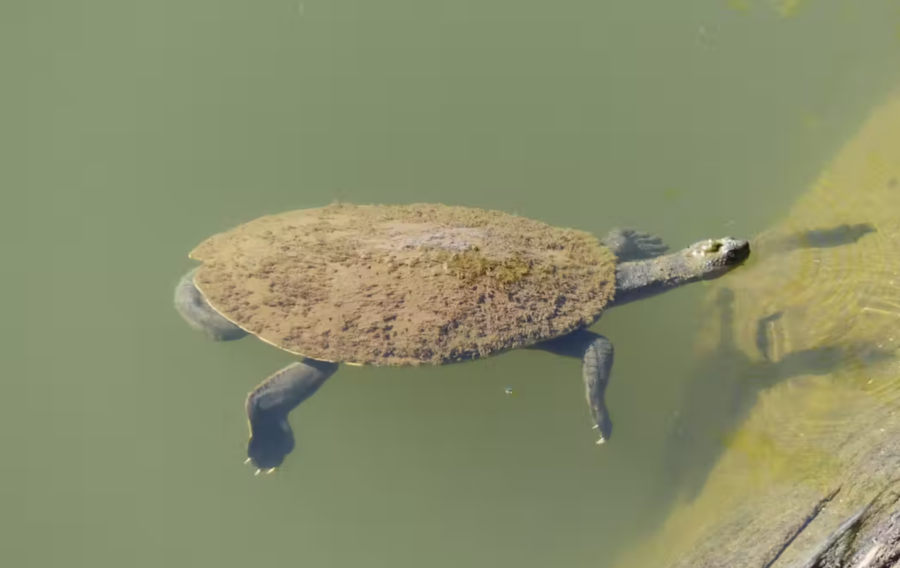The strange tale of the Mary River turtle

The first time I ever saw a Mary River turtle, I thought it looked as if it had grown too big for its shell. It had long, powerful limbs, large, webbed feet and an enormous tail – a spectacular and unique appendage containing bones that form a hook. This tail’s most remarkable feature is a deep cavity lined with gill-like structures that are used for extracting oxygen from water; it’s an unusual feature in a reptile, which would typically rely on lungs for breathing. It allows the turtle to remain submerged for long periods and has led to it and several other turtle species being known as “bum-breathers”.
Though found only in south-east Queensland’s Mary River, which flows through the subtropical city of Maryborough, many Australians would be more familiar with the species than they realise: thousands of tiny hatchlings were sold as “penny turtles” throughout the country during the 1960s and ’70s. Back then, no-one knew these belonged to a species found in only one river and that their sale – often as Christmas gifts due to their hatching time – was nudging the species towards extinction.
About 40 years ago, Sydney-based reptile expert John Cann, who ran the Snake Pit at La Perouse, realised the little turtle being sold as the common saw-shelled turtle in the pet shops of NSW and Victoria was actually a species unknown to science. At that time, the wildlife trade had its own misguided code of ethics and dealers refused to provide details of their suppliers.
John became obsessed with identifying the species and searched for almost two decades, diving and trapping in hundreds of Australian river systems and in Papua New Guinea. In 1984 the Victorian government passed legislation making it illegal to sell hatchling freshwater turtles with a shell length less than 100 mm, effectively stopping the harvest and trading of Mary River turtles. It also meant there was no longer a need to keep the collector’s name secret and John eventually tracked him down to the town of Maryborough.
The elusive Elusor macrurus
The Mary River turtle was scientifically described in 1994 and given the Latin name of Elusor macrurus: Elusor for its elusive nature and the long quest for its origin; and macrurus because of its outsized tail.
Having only recently been recognised for what it is, however, this splendid creature is already in danger of being lost.
Decades of cattle grazing, tree felling and sandmining along the river’s banks degraded water quality and turtle habitat. Dogs and foxes plunder eggs from turtle nests, and invasive plants, such as salvinia and water hyacinth, block sunlight and suck oxygen from the water. The high level of egg harvesting throughout the ’60s and ’70s has also resulted in few young turtles entering the river.
Research biologists estimate that the turtle’s total population has been depleted by more than 95 per cent from historic levels and now consists mainly of older adults. This is regarded as a warning sign of a species’ imminent extinction and the reptile has now been listed by the Turtle Conservation Fund as the world’s 20th most endangered turtle or tortoise, placing it at an even greater risk than the legendary giant tortoises of the Galapagos Islands.
Too late for the Mary River Turtle?
So, is it too late for the Mary River turtle? Fortunately, there is hope and help at both the local and national level.
Volunteer community organisation, the Tiaro and District Landcare Group, has instigated a nest-protection scheme to boost the number of hatchlings entering the river. And, by making and selling chocolate turtles, it has raised funds for conservation and research programs.
The turtle was saved from potential disaster last year after the Queensland Government’s proposal to dam the Mary River (AG 89) was rejected by the Federal Government, on the grounds it would irreversibly harm the turtle and other unique species. The battle for the turtle goes on, however. Although it has now been saved from the detrimental effects of the dam, the turtle’s future is by no means guaranteed. It remains a long, uphill battle to ensure this unique animal survives into the future.


